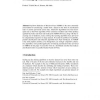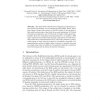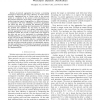321 search results - page 59 / 65 » Modeling liaison in French by using decision trees |
IFIP12
2008
13 years 8 months ago
2008
Top Down Induction of Decision Trees (TDIDT) is the most commonly used method of constructing a model from a dataset in the form of classification rules to classify previously unse...
CLIMA
2004
13 years 8 months ago
2004
Abstract. This paper deals with the issue of learning in multi-agent systems (MAS). Particularly, we are interested in BDI (Belief, Desire, Intention) agents. Despite the relevance...
INFOCOM
2010
IEEE
13 years 5 months ago
2010
IEEE
—In-network aggregation has become a promising technique for improving the energy efficiency of wireless sensor networks. Aggregating data at various nodes in the network result...
ESANN
2006
13 years 8 months ago
2006
Random Forests were introduced by Breiman for feature (variable) selection and improved predictions for decision tree models. The resulting model is often superior to AdaBoost and ...
CORR
2006
Springer
13 years 7 months ago
2006
Springer
Let S = s1, s2, s3, ..., sn be a given vector of n distinct real numbers. The rank of z R with respect to S is defined as the number of elements si S such that si z. We consider...



